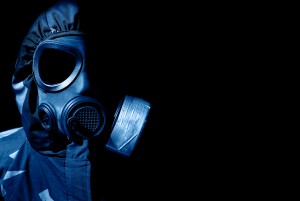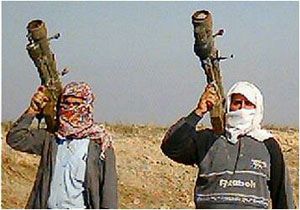08/27/2011 By Richard Weitz
Although the insurgents look to have secured control of Tripoli, Muammar el-Qaddafi’s threat to the international community has not ended. Dangers still persist from the dictator’s dabbling in weapons of mass destruction and their means of delivery.
British Foreign Secretary William Hague has said that the Gaddafi regime might try unleash Libya’s remaining chemical weapons and missiles as a means to survive. “You can’t anticipate everything the Gaddafi regime will do. They are a vicious regime. They are in their death throes. There are people still out there. That’s why we can’t rule out any of those things,” adding that, “These are still difficult and dangerous times in Libya. There are many weapons out there.”
“Even after Qadhafi is out of power, we will have to step up and lead to ensure U.S. national security interests are safeguarded.” U.S. House Intelligence Committee Chairman Mike Rogers (R-Mich.) said in a prepared statement. “In particular, we must ensure that Qadhafi’s stockpiles of advanced weapons, chemical weapons and explosives don’t fall into the wrong hands.”
Qaddafi is thought to possess several dozen Scud B missiles that could still be fired. The regime originally had more than two hundred of them but many were probably destroyed in a RAF raid a few months ago. The Scuds have a range of 200 miles and could kill a lot of people if they landed in a heavily populated area. The regime has already launched one Scud from the Gaddafi stronghold in Sirte on the opposition held town of Misurata, but it went off course. “The use of such Scud-type missiles presents a threat to civilians,” a NATO spokesman said. “They are a weapon of terror, it is utterly irresponsible.”
Still, the real danger is not from the regime using these weapons to change the course of the battle in Libya, which they cannot. Rather, it is that, if they fall into the wrong hands, they could greatly aid terrorists seeking to cause havoc in a European city or to shoot down a civilian airliner. Qaddafi has already threatened to unleash Libyan sleeper cells in European cities to conduct revenge acts of terrorism.

Recent attention has focused on Libya’s remaining chemical agents, with particular concern over the possibility that the remaining regime followers will use them against the Libyan insurgents or against other targets, such as Western civilians. The regime also has some long-range missiles and many short-range anti-aircraft weapons that, as Qaddafi’s own agents demonstrated, could be used to down a civilian airliner. But the most serious danger is that the chaos in Libya will allow terrorists to gain control of some of these weapons.
Following the American-led invasion of Iraq in March 2003, Libya agreed to relinquish its WMD programs in return for normalizing relations with Western governments and other expected benefits. The Libyan government subsequently made considerable progress in eliminating its nuclear weapons program, which had received significant assistance from the A.Q. Khan trafficking network. The United States removed Libya’s stockpiles of uranium hexafluoride, its uranium-enriching centrifuge machines, and other materials and technologies intended to construct nuclear weapons, including detailed blueprints for making an atomic bomb. Libya also eliminated its longer-range ballistic missiles.
Libya also joined the Chemical Weapons Convention (CWC) in 2004. At the time, it declared 23 metric tons of mustard agents in bulk containers. First used by German troops in World War I, mustard gas is a highly toxic sulfuric compound that can blister and burn exposed skin, causing internal and external bleeding, blindness and death. Libya also declared to the Organization of Chemical Weapons (OPCW), which administers and enforces the CWC, one inactivated chemical weapons production facility, two chemical weapons storage sites, 1,300 metric tons of precursor chemicals used for developing chemical agents, and 3,563 empty aerial bombs, which were crushed by bulldozers in 2004. Most of what remains of these chemical agents and their precursors are stored in corroding drums under regime guards at the former Rabta chemical weapons facility, located in a town south of Tripoli.
A number of factors combined to keep Libya from meeting the original 2007 deadline set by the CWC to eliminate its chemical agent stockpiles. The Libyan government initially intended to destroy them with U.S. and Italian assistance, but these partnerships failed to develop. Libyan officials also delayed granting U.S. personnel visas to monitor the elimination process. Furthermore, they claimed that environmental concerns required them to move more slowly than anticipated on the elimination process.
Qaddafi is known to have expressed irritation that he has not received sufficient rewards for eliminating his chemical weapons. In particular, he wanted to receive more Western financial assistance, the removal of more sanctions against his government, and access to civilian nuclear technology as well as personal attention from Western leaders. According to some WikiLeaked cables, Qaddafi threatened to resume his WMD programs after he was denied permission to visit Ground Zero and set up his tent camp in New York City near the site.
It was not until several years later that elimination activities began at the Ruwagha Hydrolysis and Neutralisation System using hydrolysis under caustic conditions as the destruction method. As at October 31, 2010, Libya had eliminated approximately one metric ton of chemical agent, or four percent, of its most dangerous Category 1 chemical weapons stockpile, thus meeting its phase 1deadline established by the Conference of State Parties (CSP) at its Fourteenth Session. At the beginning of November 2010, CW destruction operations were temporarily halted to allow for the installation of new destruction equipment. They resumed one month later. The elimination process stalled again last month when, shortly before the revolt began, when a heating system in the mobile chemical neutralization plant malfunctioned, leading to the withdrawal of the OPCW inspectors who were overseeing the destruction operation.
In addition to the mustard agents, in the second half of April 2010, Libya started destroying two chemical weapons precursors (Category 2 chemical agents stored in jugs at Rabta) at the Ruwagha Hydrolysis and Neutralisation System. However, after a few trials that eliminated 4.4 metric tons of phosphorous trichloride, technical problems led to the suspension of these operations. The CSP granted a Libyan request to extend its intermediate and final chemical weapon destruction deadlines. Libya must now destroy its remaining Category 1 chemical weapon stockpiles by May 15 of this year.
On February 23, after the outbreak of mass demonstrations among Libyans led to fears that the regime would resort to chemical warfare to remain in power, OPCW personnel made public their estimate that Libya had destroyed at least half of its original 23 metric tons of mustard agent. The remaining agents have probably degraded somewhat over time. Furthermore, since Libya eliminated its 3,500 empty aerial munitions, which could have been use to disperse mustard gas and other chemical agents from airplanes, Libya lacks a system to deliver any functioning chemical agents to a target. On March 11, Libya’s ambassador to the OPCW Ahmed Hassan Ahmed Walid, told OPCW director general Ahmet Üzümcü, who had requested a meeting to inquire about their status, that his government has kept the materials secure.
Some analysts also worry that Libya has some undeclared chemical weapons, both mustard gas and precursors, and perhaps some more deadly nerve agents.
During the 1970s and 1980s, the Qaddafi regime provided weapons to various foreign terrorist movements, including the Provisional Irish Republican Army, the Abu Nidal Organization, and other militant groups. Some arms depots in Iraq were looted after the March 2003 invasion created a security vacuum in that country by eliminating the Saddam Hussein regime without establishing a new security structure in its place. A similar vacuum in Libya could allow extremists to gain access to some of the chemical agents or related materials and technology.
Using NATO troops to seize or move the tons of agents at issue would be difficult. Air attacks could inflict casualties on civilians and could disperse rather than destroy some of the chemicals, making them less secure. The possibility of undeclared stocks is particularly worrisome since their location and qualities are probably unknown.
State Department spokeswoman Victoria Nuland told reporters that U.S. officials had been “monitoring known missile and chemical agent storage facilities since the start of this conflict” in February. “We believe that these known missile and chemical agent storage facilities remain secure, and we’ve not seen any activity, based on our national technical means, to give us concern that they have been compromised.”

Pentagon spokesman Colonel Dave Lapan confirmed that the sites containing the chemical weapons were safe. He said that there were no plans to send U.S. troops in to secure the chemical weapons’ sites. Still, NATO should prepare its forces to seize the material if the Libyan guards abandon their posts. Perhaps the reason they remain in storage is that Qaddafi’s forces lack the military means to use the chemical weapons since they earlier destroyed all the air bombs, shells, and missiles that could serve as a delivery vehicle for mustard gas. But they could prove attractive to terrorists or illicit traffickers who sell to them. Mustard gas can inflict severe casualties on civilians lacking protective suits or other protection.
A more recent concern is that terrorists could gain control of the hundreds of tons of raw uranium yellowcake stored at a small facility east of Tripoli. The material cannot be used to make a nuclear weapon without enrichment and other steps. But a former UN inspector noted that the yellowcake could be combined with other non-nuclear to make a “dirty bomb.” Technically known as a radioactive dispersal device, a “dirty bomb” uses conventional explosives to spew radioactive material over a wide area. It would likely kill no more people than a bomb without the radioactive coating, but the panic and economic damage it could inflict if detonated in an urban area would be enormous. People would want to avoid the area for months, and many people would self-diagnosis themselves as suffering from radiation sickness and flee to the local hospital.
The immediate worry is that some of the MANPADs (Man-Portable Air Defense Systems) Gadhafi’s forces and the rebels possess could fall into the wrong hands.
Lapan said that, “They remain a concern, because of their portability.” In April, General Carter Ham, head of U.S. Africa Command, estimated that there were perhaps 20,000 shoulder-fired anti-aircraft missiles in Libya.
The United States has given $3 million to two non-government organizations, MAG International and the Swiss Foundation for Demining, to help the National Transitional Council (NTC) secure and eliminate weapons stockpiles and unexploded munitions. They have been working with the NTC to secure such weapons in areas under the council’s control. The U.S. has also been working with Libya’s neighbors to prevent dangerous items from entering the global arms market.
Alexander Griffiths, director of operations for the Swiss Foundation for Mine Action, said his elimination teams have destroyed some MANPADS, including nearly 30 Russian SA-7 launchers, but these units only operate in zones firmly under rebel control.

